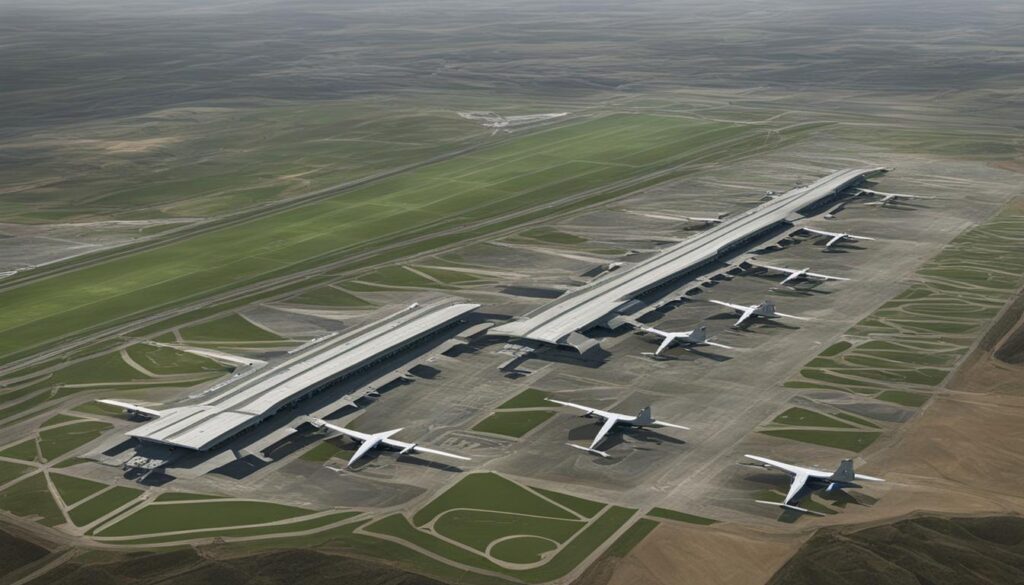How Many Airports Are in Addis Ababa?
Have you ever wondered how many airports there are in Addis Ababa, the bustling capital city of Ethiopia? You might be surprised to learn that it is home to multiple airports, serving both domestic and international travelers. From the busy Addis Ababa Bole International Airport to smaller regional airports, the city is a hub of air travel activity. So, exactly how many airports are there in Addis Ababa, and what role do they play in the Ethiopian aviation industry? Let’s explore the fascinating world of airports in Addis Ababa and uncover the key details.
Key Takeaways:
- Addis Ababa is home to multiple airports, including the busy Addis Ababa Bole International Airport.
- The city’s airports play a crucial role in facilitating both domestic and international air travel.
- There are also regional airports and military airbases in Addis Ababa.
- The efficient airport infrastructure supports both passenger travel and cargo transportation.
- Ethiopia’s airports contribute to the country’s connectivity, economy, and development.
Addis Ababa Bole International Airport
Addis Ababa Bole International Airport, with the IATA code ADD and the ICAO code HAAB, is Ethiopia’s busiest airport and one of the largest airports in Africa. As the primary airport serving Addis Ababa, it offers a wide range of domestic and international flights, connecting the city to destinations around the world. The airport serves as a hub for Ethiopian Airlines, the national carrier of Ethiopia, which operates numerous flights to and from Addis Ababa.
This bustling airport provides modern facilities, including passenger terminals and cargo handling facilities, ensuring a seamless travel experience for both leisure and business travelers. Whether you’re flying within Ethiopia or embarking on an international journey, Addis Ababa Bole International Airport is well-equipped to accommodate your needs.
With its strategic location and excellent connectivity, Bole International Airport plays a significant role in facilitating air travel to and from Ethiopia. Passengers can enjoy a range of amenities, including duty-free shopping, dining options, and comfortable lounges. The airport’s efficient services and friendly staff ensure that travelers have a pleasant and convenient experience from the moment they arrive until they board their flights.
Other Public Airports in Addis Ababa
In addition to Addis Ababa Bole International Airport, there are several other public airports in Addis Ababa and its surrounding regions. These airports cater to domestic flights and connect various cities within Ethiopia. Some of the notable public airports in Addis Ababa include Arba Minch Airport, Asosa Airport, Awasa Airport, Axum Airport, Bahir Dar Airport, and more. These airports play an important role in facilitating air travel within Ethiopia and providing convenient connections for travelers.
Regional Airports in Ethiopia
In addition to the public airports in Addis Ababa, there are several regional airports located throughout Ethiopia. These airports serve as important transportation hubs, connecting various cities and towns within the country. Some notable regional airports in Ethiopia include Gondar Airport, Jimma Airport, Jijiga Gerad Wilwal Airport, Lalibela Airport, and more. These regional airports contribute to the development of regional connectivity and provide access to different parts of Ethiopia.
Military Airports in Addis Ababa

Apart from public airports, Addis Ababa is also home to military airports that serve the Ethiopian Air Force and support military aviation operations. These military airports play a crucial role in ensuring national security and defense capabilities in Ethiopia.
Lideta Army Airport (ICAO: HAAL)
Lideta Army Airport, with the ICAO code HAAL, is one of the military airports located in Addis Ababa. As an important Ethiopian Air Force base, Lideta Army Airport plays a significant role in supporting military operations and training.
Harar Meda Airport (ICAO: HAHM)
Harar Meda Airport, identified by the ICAO code HAHM, is another military airport situated in Addis Ababa. This strategic airbase supports the Ethiopian Air Force and contributes to the country’s defense capabilities.
The presence of these military airports highlights the importance of aviation in Ethiopia, not only in civilian air travel but also in national security and defense. The Ethiopian Air Force bases in Addis Ababa ensure the country’s preparedness and readiness to safeguard its interests.
Airports in Other Regions of Ethiopia

In addition to the airports in Addis Ababa, Ethiopia is home to several regional airports that serve as vital transportation hubs. These airports play a crucial role in connecting various cities and towns within the country, facilitating domestic air travel and contributing to the development of regional connectivity.
Some notable regional airports in Ethiopia include:
Gondar Airport (ICAO: HAGN, IATA: GDQ)
Gondar Airport, with the ICAO code HAGN and the IATA code GDQ, is located in the city of Gondar. It serves as an important gateway to the historic sites of Ethiopia, including the Royal Enclosure.
Jimma Airport (ICAO: HAJM, IATA: JIM)
Jimma Airport, with the ICAO code HAJM and the IATA code JIM, is situated in Jimma. It serves as a key airport for travelers visiting the Jimma Zone and the surrounding areas.
Jijiga Gerad Wilwal Airport (ICAO: HAJJ, IATA: JIJ)
Jijiga Gerad Wilwal Airport, with the ICAO code HAJJ and the IATA code JIJ, is located in Jijiga. It serves as an important hub for passengers traveling to the Somali Region of Ethiopia.
Lalibela Airport (ICAO: HALL, IATA: LLI)
Lalibela Airport, with the ICAO code HALL and the IATA code LLI, is situated in Lalibela. It provides access to the world-famous rock-hewn churches, a UNESCO World Heritage Site.
These regional airports, along with many others in Ethiopia, contribute to the accessibility and connectivity of different parts of the country. They play a crucial role in supporting domestic air travel and enhancing airport infrastructure throughout Ethiopia.
The Biggest Airports in Ethiopia
When it comes to the largest airports in Ethiopia, Addis Ababa Bole International Airport stands as the busiest and one of the largest airports in Africa. Located in Addis Ababa, the capital city of Ethiopia, this airport serves as a vital air travel hub in the country.
In addition to Addis Ababa Bole International Airport, there are several other significant airports in Ethiopia that handle substantial passenger traffic and boast modern infrastructure. These airports play a pivotal role in the country’s air travel industry.
One such airport is Dire Dawa International Airport (ICAO: HADR, IATA: DIR), which operates domestic and international flights. Another key airport is Mekele Airport (ICAO: HAMK, IATA: MQX), which serves as a gateway to the northern region of Ethiopia.
Furthermore, Gonder Airport (ICAO: HAGN, IATA: GDQ), located in the city of Gonder, is another significant airport that contributes to Ethiopia’s air travel infrastructure. Lastly, Gambella Airport (ICAO: HAGM, IATA: GMB) in the Gambella region handles a consistent flow of domestic and international flights.
These airports collectively accommodate a high volume of passenger traffic, serving as crucial gateways to explore Ethiopia’s vibrant culture, history, and natural beauty.
Freight Volume in Ethiopian Airports
Ethiopian airports play a crucial role in facilitating not only passenger travel but also cargo transportation. In 2021, the total freight volume transported by air in Ethiopia amounted to approximately 3.72 billion ton-kilometers. This includes the transportation of various goods and commodities through the airports in Ethiopia. The efficient cargo handling facilities and infrastructure in Ethiopian airports support the country’s trade and contribute to its economic growth.
Conclusion
In summary, Ethiopia is home to a diverse range of airports, with Addis Ababa serving as the primary air travel hub in the country. From the bustling Addis Ababa Bole International Airport, Ethiopia’s busiest airport and one of the largest in Africa, to regional airports and military airbases, the country’s aviation infrastructure caters to both domestic and international air travel.
These airports play a crucial role in connecting various cities and regions within Ethiopia, facilitating passenger travel, and supporting the transportation of cargo. With continuous growth and development in the Ethiopian aviation industry, these airports contribute significantly to the country’s connectivity, economy, and overall development.
Whether it’s the convenience of domestic flights, the wide range of international connections, or the efficient cargo handling facilities, Ethiopia’s airports continue to enhance the nation’s air travel experience. They serve as vital gateways for travelers and key contributors to Ethiopia’s continued growth and prominence in the global aviation industry.




